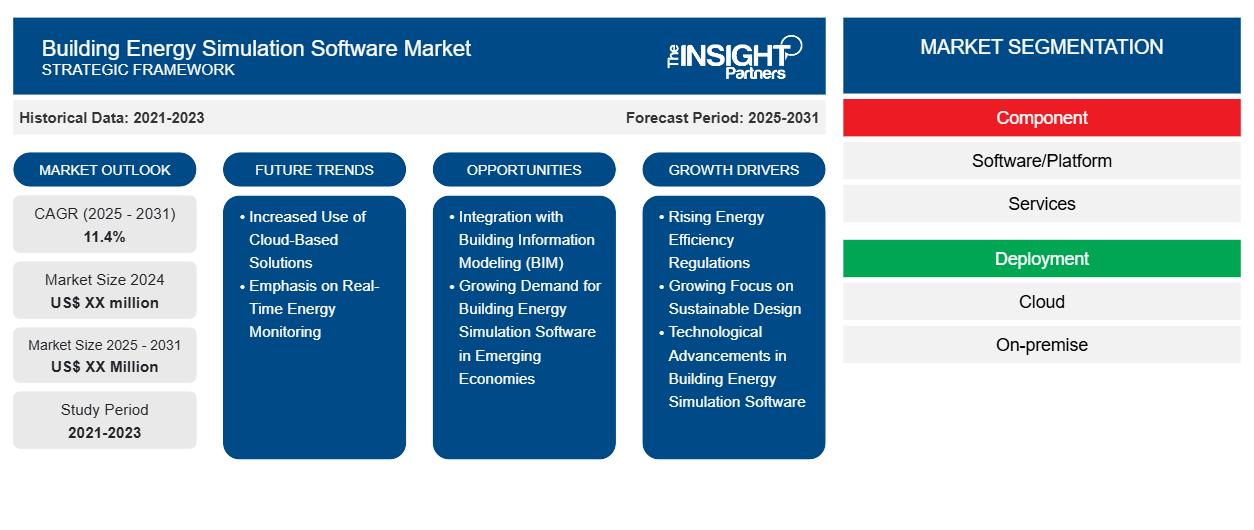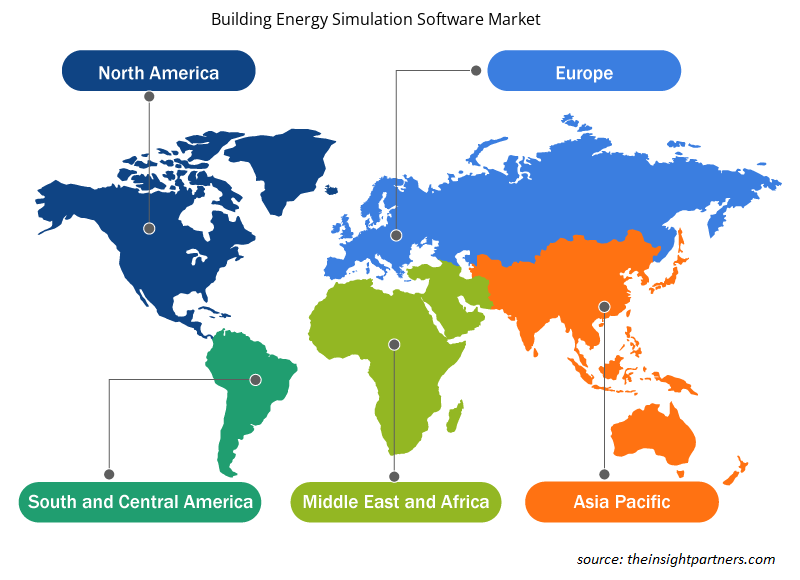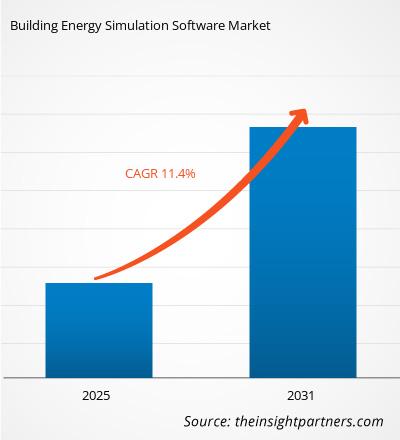The Building Energy Simulation Software Market is expected to register a CAGR of 11.4% from 2025 to 2031, with a market size expanding from US$ XX million in 2024 to US$ XX Million by 2031.
The report is segmented by Component (Software/Platform, Services); Deployment (Cloud, On-premise); End User (Owner, Builder, Researcher). The global analysis is further broken-down at regional level and major countries. The report offers the value in USD for the above analysis and segments
Purpose of the Report
The report Building Energy Simulation Software Market by The Insight Partners aims to describe the present landscape and future growth, top driving factors, challenges, and opportunities. This will provide insights to various business stakeholders, such as:
- Technology Providers/Manufacturers: To understand the evolving market dynamics and know the potential growth opportunities, enabling them to make informed strategic decisions.
- Investors: To conduct a comprehensive trend analysis regarding the market growth rate, market financial projections, and opportunities that exist across the value chain.
- Regulatory bodies: To regulate policies and police activities in the market with the aim of minimizing abuse, preserving investor trust and confidence, and upholding the integrity and stability of the market.
Building Energy Simulation Software Market Segmentation
Component
- Software/Platform
- Services
Deployment
- Cloud
- On-premise
End User
- Owner
- Builder
- Researcher
Geography
- North America
- Europe
- Asia-Pacific
- South and Central America
- Middle East and Africa
Customize This Report To Suit Your Requirement
You will get customization on any report - free of charge - including parts of this report, or country-level analysis, Excel Data pack, as well as avail great offers and discounts for start-ups & universities
Building Energy Simulation Software Market: Strategic Insights

- Get Top Key Market Trends of this report.This FREE sample will include data analysis, ranging from market trends to estimates and forecasts.
Building Energy Simulation Software Market Growth Drivers
- Rising Energy Efficiency Regulations: Governments worldwide are implementing stricter energy efficiency regulations and building codes to combat climate change and reduce energy consumption. This regulatory pressure drives the adoption of building energy simulation software, as architects, engineers, and building managers seek tools to ensure compliance with these standards. By using simulation software, stakeholders can analyze energy usage, identify inefficiencies, and design buildings that meet or exceed regulatory requirements. As the demand for sustainable construction practices grows, the market for building energy simulation software is expected to expand significantly.
- Growing Focus on Sustainable Design: There is a heightened awareness of the environmental impact of buildings, leading to a growing focus on sustainable design practices. Building energy simulation software enables professionals to evaluate the energy performance of buildings during the design phase, allowing for better decision-making regarding materials, systems, and layouts. By facilitating the creation of energy-efficient buildings, this software supports the global shift toward sustainability. As more organizations prioritize eco-friendly designs, the demand for building energy simulation tools will continue to rise.
- Technological Advancements in Building Energy Simulation Software: Technological advancements in building energy simulation software, such as improved algorithms and enhanced modeling capabilities, are driving market growth. These innovations enable more accurate predictions of energy consumption and performance, leading to better design decisions and operational efficiencies. Furthermore, the integration of artificial intelligence (AI) and machine learning (ML) in simulation tools allows for the analysis of vast data sets, enhancing the software’s predictive capabilities. As technology continues to evolve, the building energy simulation software market will likely benefit from increased adoption and investment.
Building Energy Simulation Software Market Future Trends
- Increased Use of Cloud-Based Solutions: A notable trend in the building energy simulation software market is the shift towards cloud-based solutions. Cloud technology allows for greater accessibility, collaboration, and scalability, enabling teams to work together on projects from different locations. This trend is particularly beneficial for large-scale projects, where multiple stakeholders need to access and share data in real time. Cloud-based simulation tools also reduce the need for expensive hardware and software maintenance, making them more appealing to organizations of all sizes. As remote work becomes more prevalent, the demand for cloud-based energy simulation solutions will likely continue to grow.
- Emphasis on Real-Time Energy Monitoring: The trend towards real-time energy monitoring is reshaping the building energy simulation software landscape. With the integration of Internet of Things (IoT) technology, building managers can now monitor energy consumption in real time, allowing for immediate adjustments and optimizations. This capability enhances the effectiveness of energy simulation software by providing accurate, up-to-date data for analysis. As organizations increasingly seek to improve operational efficiencies and reduce energy costs, the demand for software that supports real-time energy monitoring will become more pronounced, driving innovation within the market.
Building Energy Simulation Software Market Opportunities
- Integration with Building Information Modeling (BIM): The integration of building energy simulation software with Building Information Modeling (BIM) presents significant opportunities for market growth. BIM allows for comprehensive visualization and management of building data throughout its lifecycle, while energy simulation tools can enhance this process by providing insights into energy performance. By combining these technologies, architects and engineers can optimize building designs for energy efficiency, leading to more sustainable outcomes. As the adoption of BIM continues to grow, the demand for compatible energy simulation software will also increase, creating opportunities for software developers.
- Growing Demand for Building Energy Simulation Software in Emerging Economies: The building energy simulation software market is poised for growth in emerging markets, where urbanization and infrastructure development are accelerating. As countries in regions such as Asia-Pacific and Latin America invest in new construction projects, there is an increasing need for energy-efficient building designs. By offering tailored solutions that address the specific needs of these markets, software providers can capitalize on this opportunity. Increasing awareness of energy efficiency and sustainable practices will further drive demand for building energy simulation software in these regions.
Building Energy Simulation Software Market Regional Insights
The regional trends and factors influencing the Building Energy Simulation Software Market throughout the forecast period have been thoroughly explained by the analysts at Insight Partners. This section also discusses Building Energy Simulation Software Market segments and geography across North America, Europe, Asia Pacific, Middle East and Africa, and South and Central America.

- Get the Regional Specific Data for Building Energy Simulation Software Market
Building Energy Simulation Software Market Report Scope
| Report Attribute | Details |
|---|---|
| Market size in 2024 | US$ XX million |
| Market Size by 2031 | US$ XX Million |
| Global CAGR (2025 - 2031) | 11.4% |
| Historical Data | 2021-2023 |
| Forecast period | 2025-2031 |
| Segments Covered |
By Component
|
| Regions and Countries Covered | North America
|
| Market leaders and key company profiles |
Building Energy Simulation Software Market Players Density: Understanding Its Impact on Business Dynamics
The Building Energy Simulation Software Market market is growing rapidly, driven by increasing end-user demand due to factors such as evolving consumer preferences, technological advancements, and greater awareness of the product's benefits. As demand rises, businesses are expanding their offerings, innovating to meet consumer needs, and capitalizing on emerging trends, which further fuels market growth.
Market players density refers to the distribution of firms or companies operating within a particular market or industry. It indicates how many competitors (market players) are present in a given market space relative to its size or total market value.
Major Companies operating in the Building Energy Simulation Software Market are:
- 4M S.A.
- Autodesk, Inc.
- Batia Construction
- Carmel Software Corporation
- Carrier Corporation
Disclaimer: The companies listed above are not ranked in any particular order.

- Get the Building Energy Simulation Software Market top key players overview
Key Selling Points
- Comprehensive Coverage: The report comprehensively covers the analysis of products, services, types, and end users of the Building Energy Simulation Software Market, providing a holistic landscape.
- Expert Analysis: The report is compiled based on the in-depth understanding of industry experts and analysts.
- Up-to-date Information: The report assures business relevance due to its coverage of recent information and data trends.
- Customization Options: This report can be customized to cater to specific client requirements and suit the business strategies aptly.
The research report on the Building Energy Simulation Software Market can, therefore, help spearhead the trail of decoding and understanding the industry scenario and growth prospects. Although there can be a few valid concerns, the overall benefits of this report tend to outweigh the disadvantages.
- Historical Analysis (2 Years), Base Year, Forecast (7 Years) with CAGR
- PEST and SWOT Analysis
- Market Size Value / Volume - Global, Regional, Country
- Industry and Competitive Landscape
- Excel Dataset



Report Coverage
Revenue forecast, Company Analysis, Industry landscape, Growth factors, and Trends

Segment Covered
This text is related
to segments covered.

Regional Scope
North America, Europe, Asia Pacific, Middle East & Africa, South & Central America

Country Scope
This text is related
to country scope.
Frequently Asked Questions
Some of the customization options available based on the request are an additional 3-5 company profiles and country-specific analysis of 3-5 countries of your choice. Customizations are to be requested/discussed before making final order confirmation# as our team would review the same and check the feasibility
The report can be delivered in PDF/PPT format; we can also share excel dataset based on the request
Integration with IoT-enabled smart building systems to play a significant role in the global building energy simulation software market in the coming years
Increasing energy efficiency mandates and growing sustainability emphasis are the major factors driving the building energy simulation software market
The Building Energy Simulation Software Market is estimated to witness a CAGR of 11.4% from 2023 to 2031
Trends and growth analysis reports related to Technology, Media and Telecommunications : READ MORE..
1.4M S.A.
2.Autodesk, Inc.
3.Batia Construction
4.Carmel Software Corporation
5.Carrier Corporation
6.DesignBuilder Software Ltd.
7.EDSL (Environmental Design Solutions Ltd)
8.EnergyCAP, Inc.
9.EnergyPeriscope (Solar Investments Inc)
10.IES (Integrated Environmental Solutions) Limited

 Get Free Sample For
Get Free Sample For